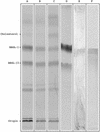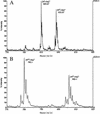A newly discovered cholesteryl galactoside from Borrelia burgdorferi
- PMID: 12799465
- PMCID: PMC164687
- DOI: 10.1073/pnas.1232451100
A newly discovered cholesteryl galactoside from Borrelia burgdorferi
Abstract
Two major glycolipids, which comprise approximately 36% of the total lipid mass from Borrelia burgdorferi, the etiological agent of Lyme disease, were investigated. We determined the fatty acid type, sugar identity, anomeric configuration, and substituent type and position. The structures were identified as cholesteryl 6-O-acyl-beta-d-galactopyranoside (B. burgdorferi glycolipid 1, BbGL-I), and 1,2-di-O-acyl-3-O-alpha-d-galactopyranosyl-sn-glycerol (BbGL-II). The major fatty acids were palmitate and oleate. The structures were corroborated by gas-liquid chromatography MS, matrix-assisted laser desorption/ionization time-of-flight spectroscopy, fast atom bombardment MS, detailed NMR spectrometry, and metabolic labeling. This is a previously undescribed demonstration of a cholesteryl galactoside in bacteria. Lipopolysaccharide was not detected in B. burgdorferi. The two glycolipids have several properties suggesting they may function as lipopolysaccharide: both are main components of the bacterial membrane, surface exposed, and have a three-domain structure. BbGL-I elicited specific antibodies in mice and rabbits, and BbGL-II elicited antibodies that reacted with both glycolipids.
Figures






Similar articles
-
Synthesis and antigenicity of BBGL-2 glycolipids of Borrelia burgdorferi, the causative agent of Lyme disease.Carbohydr Res. 2011 Sep 6;346(12):1551-63. doi: 10.1016/j.carres.2011.04.045. Epub 2011 May 3. Carbohydr Res. 2011. PMID: 21601180 Free PMC article.
-
Acylated cholesteryl galactoside as a novel immunogenic motif in Borrelia burgdorferi sensu stricto.J Biol Chem. 2003 Sep 5;278(36):33645-53. doi: 10.1074/jbc.M305799200. Epub 2003 Jun 16. J Biol Chem. 2003. PMID: 12810705
-
Structural analysis of glycolipids from Borrelia burgdorferi.Biochimie. 2001 Jul;83(7):683-92. doi: 10.1016/s0300-9084(01)01296-2. Biochimie. 2001. PMID: 11522398
-
Analysis of phospolipids and glycolipids by thin-layer chromatography-matrix-assisted laser desorption and ionization mass spectrometry.J Chromatogr A. 2012 Oct 12;1259:62-73. doi: 10.1016/j.chroma.2012.03.068. Epub 2012 Mar 28. J Chromatogr A. 2012. PMID: 22503924 Review.
-
Phases and phase transitions of the glycoglycerolipids.Chem Phys Lipids. 1994 Mar 1;69(3):181-207. doi: 10.1016/0009-3084(94)90001-9. Chem Phys Lipids. 1994. PMID: 8194156 Review.
Cited by
-
Natural killer cells and natural killer T cells in Lyme arthritis.Arthritis Res Ther. 2013 Nov 7;15(6):R183. doi: 10.1186/ar4373. Arthritis Res Ther. 2013. PMID: 24286535 Free PMC article.
-
Spirochetal motility and chemotaxis in the natural enzootic cycle and development of Lyme disease.Curr Opin Microbiol. 2015 Dec;28:106-13. doi: 10.1016/j.mib.2015.09.006. Epub 2015 Nov 2. Curr Opin Microbiol. 2015. PMID: 26519910 Free PMC article. Review.
-
Lyme Disease in Humans.Curr Issues Mol Biol. 2021;42:333-384. doi: 10.21775/cimb.042.333. Epub 2020 Dec 11. Curr Issues Mol Biol. 2021. PMID: 33303701 Free PMC article.
-
Hypercholesterolemia and ApoE deficiency result in severe infection with Lyme disease and relapsing-fever Borrelia.Proc Natl Acad Sci U S A. 2015 Apr 28;112(17):5491-6. doi: 10.1073/pnas.1502561112. Epub 2015 Apr 13. Proc Natl Acad Sci U S A. 2015. PMID: 25870274 Free PMC article.
-
Effect of levels of acetate on the mevalonate pathway of Borrelia burgdorferi.PLoS One. 2012;7(5):e38171. doi: 10.1371/journal.pone.0038171. Epub 2012 May 31. PLoS One. 2012. PMID: 22675445 Free PMC article.
References
MeSH terms
Substances
LinkOut - more resources
Full Text Sources
Other Literature Sources
Medical
Molecular Biology Databases

